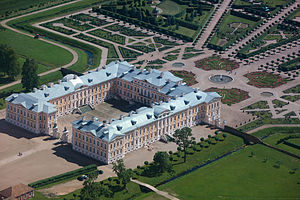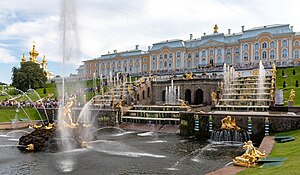List of Transbaltian Royal Residences
Transbaltian royal residences are palaces, castles and houses occupied by members of the Transbaltian royal and ducal families in the Grand Duchy of Transbaltia. Some, like Tavliga Palace and Runesburg Palace, are owned by the Royal or Ducal crowns (ownership by the Grand Duke or Duke is by virtue of his or her position.), while others like Kastroka Castle and Woltenburg Manor are personally owned and have been passed down for generations. Some royal palaces, such as the Palace of Borstadt, are no longer residences but serve government, historical or cultural purposes. Some remain in irregular use for royal occasions, such as Hansburghof in Konigshafen.
- Tavliga Palace. Located in Tavliga it is the seat of the Grand Duke. It was constructed between 1780 and 1789 for Grand Duke Otto I, and was marvelled as one of the largest royal residences in the world.
- Runesburg Palace. Located in rural Cisvilia, it is the retreat of the Grand Duke. It was constructed for Grand Duke Augustus, the consort of Transbaltia and the Elector of Runesburg in Dolchland.
- Palace of Borstadt. Also located in Tavliga. It was constructed to house the royal court and the royal estate, and has since become the seat of the Kanzler.
Estates of Ahranian royals in Transbaltia
During Transbaltia's period under Ahranian rule, dozens of palaces and manors were constructed for Ahranian and Uppsunder royals and nobles, who were attracted to the warmer climates of southern Transbaltia. After the 1912 Transbaltian Declaration of Independence, all assets of Ahranian authority were seized, however after seeing how Ahranian royals were treated in the new nationalist state, Grand Duke Friedrich issued an act to redistribute a number of seized estates to those forced into exile. After the 1937 re-establishment of the monarchy in Ahrana, acts were passed to resize a few palaces, whilst also properly allocating some residences for the monarch and specific members of the Ahranian nobility.
Similar acts were passed following the socialist takeover of Ahrana, providing shelter for not only nobles but many Ahranians forced into exile. For a time these palaces were the centre of the Ahranian exile community. There still exists calls on both sides for what to do with the palaces. Some argue that all Transbaltian palaces should be free from foreign ownership, whilst others argue that the seizure of palaces in 1912 was illegal and that they ought to be returned to Ahranian nobility.












